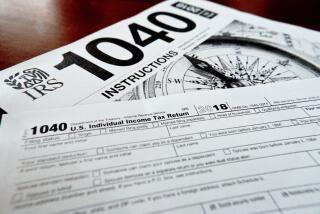Estimated Tax Payments Can Be Stitch in Time
“Joe Taxpayer” started his own consulting business in 1984 and was delighted with its success. He realized that he was going to owe some tax but, instead of making estimated tax payments throughout the year, he decided to wait until he filed his 1984 return so that he could use his money for other purposes.
Since he did not have the time nor the money to file his return on April 15, 1985, he applied for an extension of time to file. And when he finally got around to filing his returns in October, 1985, he was dismayed to find that he owed $19,000 to the federal and state tax authorities.
He was barely able to come up with the cash, but then three months later he received notices from the Internal Revenue Service and the California Franchise Tax Board asking for $7,000 more in interest and penalties.
If, like Joe, you’ve been thinking about hanging onto your tax dollars as long as possible, be careful. Besides having to pay interest for failing to pay your tax when due, you can be subject to various penalties if you fail to play by rules established by both the IRS and the state of California. While the interest you pay is deductible, the penalties are not, which increases their effective cost.
There are three basic types of penalties that affect normal filing of income tax returns: the underestimation penalty, the late filing penalty and the late payment penalty.
The first type of penalty relates to underpayment of estimated tax. Both the federal government and California require that all taxpayers pay at least 80% of their tax liability by Jan. 15 of the following year.
If you are an employee, your payments will normally be taken care of through withholding from your wages, but it is your responsibility (not your employer’s) to be certain that enough is withheld. If you are self-employed, or otherwise have no withholding, you are required to make quarterly estimated tax payments to cover 80% of your tax liability.
In order to avoid the harshness of requiring people to constantly keep track of their tax liability throughout the year, both the IRS and California provide exceptions under which a penalty may not apply.
One way to avoid a penalty is by paying an amount equal to at least as much as your previous year’s tax (provided that a return was filed for that year and showed a tax liability). An individual can also avoid a penalty by making quarterly payments based on estimates of annual income.
This exception is rarely used but can be beneficial to someone who has a “windfall” late in the year. There is also a provision in the law that allows the IRS to waive the penalty in cases of hardship, but it is best not to rely on the government’s understanding.
When no exceptions are met, and at least 80% of the tax has not been paid, the penalty is computed based on the prevailing penalty rate for the period of time that the underpayment occurred.
The second type of penalty applies to individuals who fail to file their returns by the due date. Both the IRS and California assess a penalty of 5% per month up to a maximum of 25% of the tax due. Both laws further provide that, if the return is delinquent more than 60 days without reasonable cause, the minimum penalty is $100.
California assesses the penalty based on the tax shown on the return, before payments, so the penalty may apply even if the return shows that a refund is due.
The IRS, on the other hand, normally will not assess a late payment penalty if the return shows a refund but can still assess a penalty based on 5% of the tax per month up to a maximum of 25% if the late filing is due to negligence.
People who request an extension of time to file their returns must recognize that extensions do not extend the time to pay the tax. If you seek an extension but fail to pay-in at least 90% of your tax liability by the regular due date, you may be subject to the late filing penalty when you file your return.
Finally, failing to pay your tax liability in full by April 15 will subject you to a late payment penalty. On the federal return, the penalty is 0.5% per month on the unpaid balance to a maximum of 25%. California assesses a penalty of 5% plus 0.5% per month on the unpaid balance up to a maximum of 23%.
Neither the IRS nor California will assess the late payment penalty for the same period of time that a late filing penalty has been assessed.
The penalties discussed here deal only with penalties for a taxpayer’s unintentional failure to pay tax and file returns in a timely manner.
But, both the IRS and California have other, more serious penalties that can be imposed in cases of negligence, fraud or intentional disregard of the rules and regulations.
More to Read
Inside the business of entertainment
The Wide Shot brings you news, analysis and insights on everything from streaming wars to production — and what it all means for the future.
You may occasionally receive promotional content from the Los Angeles Times.










